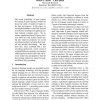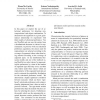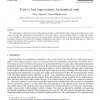266 search results - page 3 / 54 » Is Combining Classifiers Better than Selecting the Best One |
EMNLP
2009
13 years 4 months ago
2009
The recent availability of large corpora for training N-gram language models has shown the utility of models of higher order than just trigrams. In this paper, we investigate meth...
EMNLP
2007
13 years 8 months ago
2007
In this paper we explore the use of selectional preferences for detecting noncompositional verb-object combinations. To characterise the arguments in a given grammatical relations...
WSCG
2001
13 years 8 months ago
2001
Studies in the area of Pattern Recognition have indicated that in most cases a classifier performs differently from one pattern class to another. This observation gave birth to th...
DAM
2006
13 years 7 months ago
2006
When applying the 2-opt heuristic to the travelling salesman problem, selecting the best improvement at each iteration gives worse results on average than selecting the first impr...
DRR
2009
13 years 4 months ago
2009
We investigate in this paper the combination of DBN (Dynamic Bayesian Network) classifiers, either independent or coupled, for the recognition of degraded characters. The independ...



